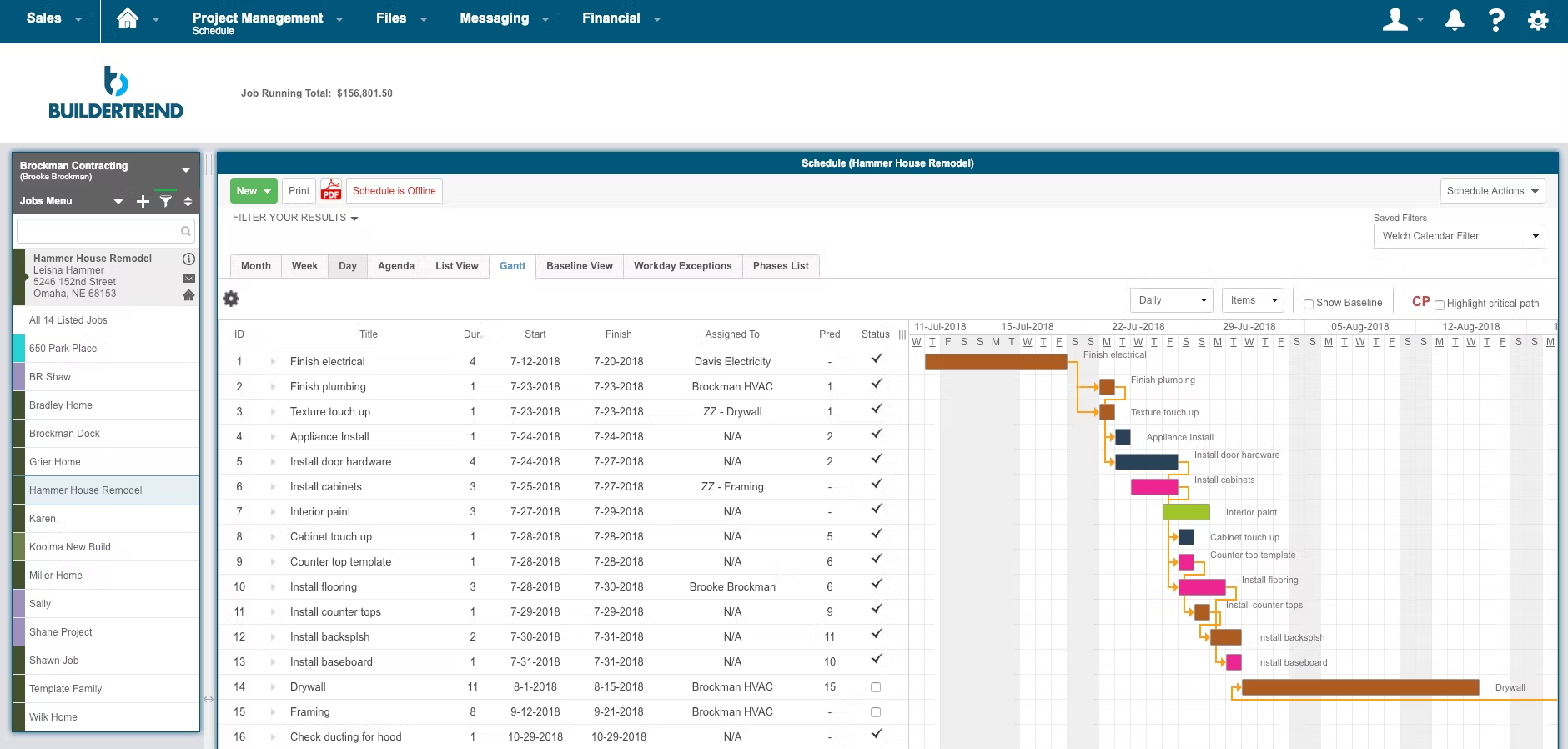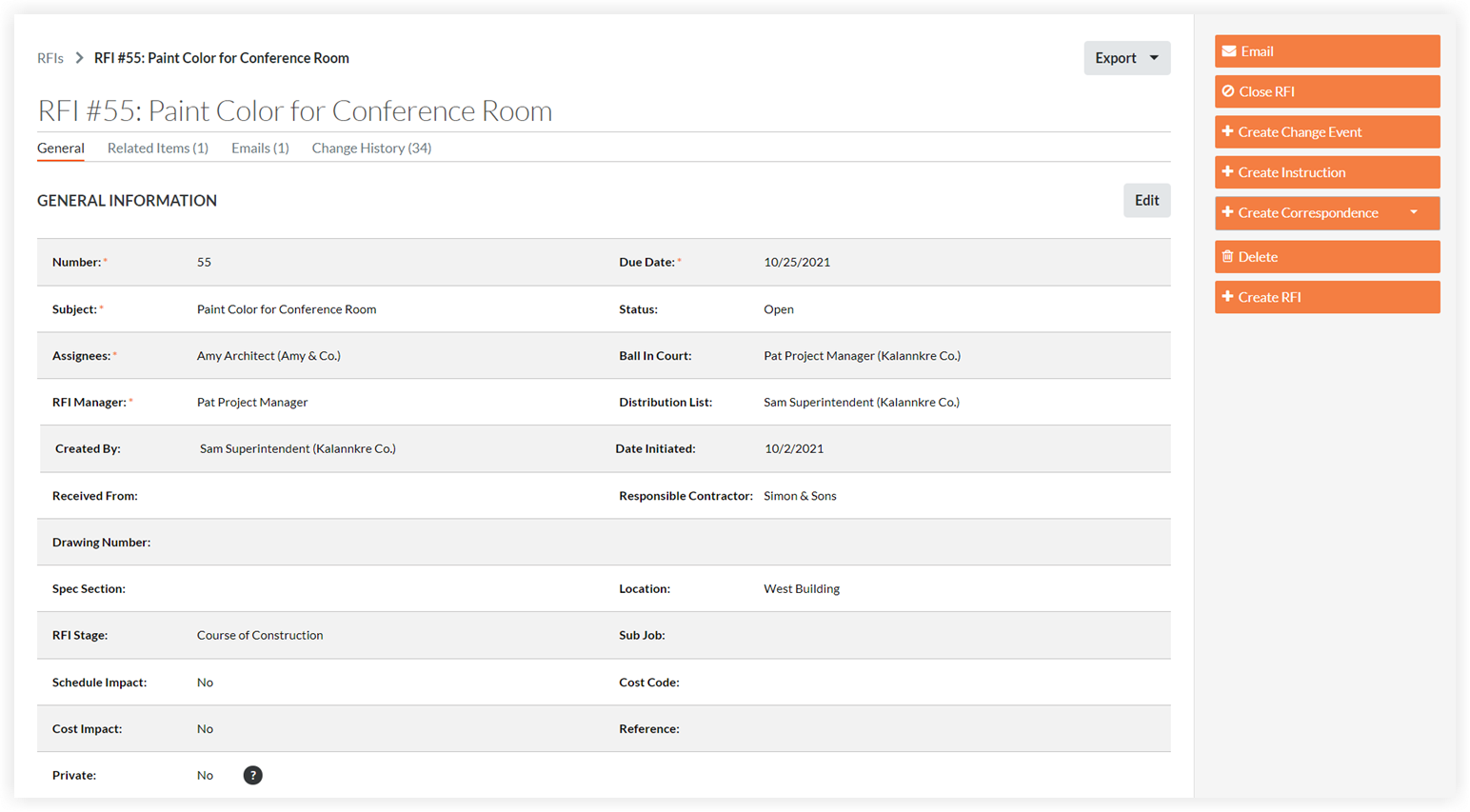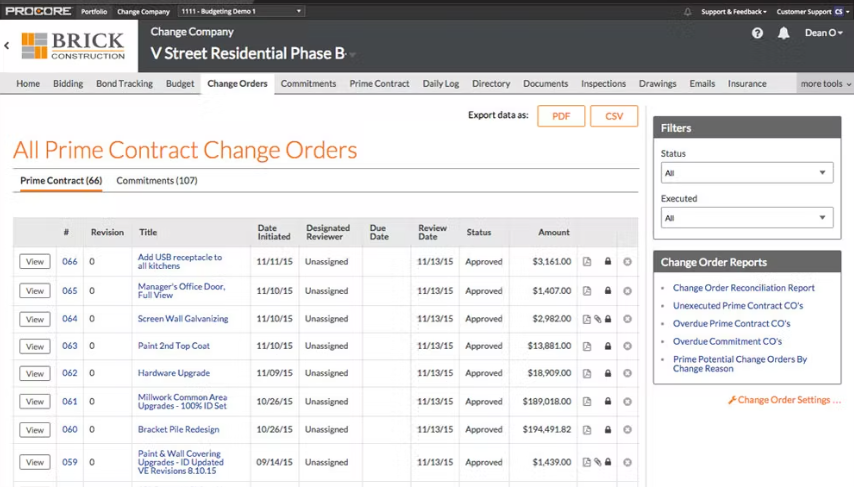How to Make the Most of Your Construction Scheduling Software
Scheduling is important in any industry, but especially in construction when missed deadlines can cost big money and have ripple effects across entire projects. And even if you have the right construction scheduling software in place, you could still be missing out on its most important benefits if you’re not using it correctly.
To help small construction firms make sure they’re getting everything they should out of their construction scheduling software, we spoke to an expert on the subject: Whitney Hill, cofounder of SnapADU.
A unique opportunity with unique challenges
As a real estate investor with a background in process improvement and technology, Hill was uniquely poised to take advantage of a market opportunity when regulations for building accessory dwelling units were relaxed in the San Diego area.
She partnered up with Mike Moore, a general contractor with decades of experience, and SnapADU was born. As SnapADU grew, the need for more technology quickly became noticeable. Scheduling three or four jobs at a time manually was one thing, but as the jobs piled on it became clear that her team was in need of construction scheduling software.

“We have 50 projects in flight right now between design, permitting, and build. We do about $15 million in revenue each year. We have 16 employees,” Hill said. “So we use our (construction) management software extensively… We’ve really embraced it wholeheartedly to ensure that everyone’s on the same page from our team to the subcontractors to the client.”
Whitney Hill, cofounder of SnapADU[1]
Construction software users who only use the basic scheduling capabilities are spending more time and effort than they need to keep jobs running smoothly. For maximum impact, you and your team should use scheduling templates, collaboration tools, and change tracking every single day. In this article, we’ll provide four key insights for how to get the most out of your construction scheduling software based on Hill’s experience.
Use schedule templates to save time on schedule creation and ensure consistency
One of the first lessons that Hill learned as SnapADU began to grow rapidly was that creating a new construction schedule from scratch for each new job would be unsustainable.
The solution? Schedule templates.
“Every job that we start has the same template imported, and it’s extremely detailed. I think we have 120 schedule items in it at this point, and each of those triggers To Dos and invoices,” Hill said. “So when we start a new job, we go in and tweak the schedule to reflect what’s going to happen on that job to deal with special situations like a coastal zone where it requires additional permitting, (or it) might have solar on it or not, or it might have fire rated construction (or) a retaining wall.”

A schedule in Buildertrend with a menu of previous job templates to choose from (source)
Feature overview:
Schedule templates allow construction managers to create and save schedules, and then reuse those schedules as templates for new jobs while adding or removing elements to reflect the exact specifications of a new job. When a new job is similar to a previous job, this can save countless hours as jobs grow exponentially.
It may seem like adjusting the template for each of those variables would take a lot of time. But think about how long it would take to manually schedule out those variables from scratch each time, as opposed to just checking or unchecking a box to add in a day for installing solar panels, for example.
And since templated schedule pieces have already been created and used in the field, those standardized pieces of the schedule can be included or removed from a new schedule with very little oversight.
“Because (we) have a very black and white description of these features, (someone) can go through and delete the stuff that we don’t need,” Hill said. “And that ensures that the same core schedule is going to be there and we’re updating that template anytime we have a change to our process flow.”
Ready to make the most of schedule templates in your new construction scheduling software? Here are some tips for next steps:
Start as soon as possible. When you’re first starting out with only a few jobs, you may not even need schedule templates. But each template you create lays the groundwork for future job schedules, and you’ll be thankful to have them down the line when you really need them.
Find someone who is familiar with your construction software to create schedule templates. When Hill was tasked with inputting all of SnapADU’s schedule items into their construction platform—Buildertrend—she wasn’t yet totally familiar with the software herself. So she found someone on a temp work platform who had already worked professionally with Buildertrend.“I was able to work with her to let her know what we needed to do, then she could implement overnight and get everything set up,” Hill said. “I was able to learn so much more quickly having her doing that with me because she’s been living and breathing Buildertrend for years. I would highly recommend making that investment.”
Don’t rely on vendor support alone. Hill said that her software vendor’s support was good, “but it’s not enough to really get you going as fast as you need to and to tailor it to your business.” This is where Hill’s contracted scheduling professional came in, and it went so well that the hire eventually joined the team full time as a project manager.
“That was huge for us,” she said. “I had someone to immediately come in and run the operation once we set up those workflows.”
Use collaboration tools to communicate and confirm schedule changes, set up automatic notifications, and save time spent on phone calls
Standardized communication is an ongoing struggle for project managers in all fields, but it is especially important in construction when you have teams working on multiple jobs across multiple sites with so many moving parts.
“There was a lot of noise when an email went out to five people and it wasn’t clear who should be on point for the next action,” Hill said.
The solution for her team was to standardize the use of the communication and collaboration features within their construction software.
Feature overview:
Collaboration tools are features included in a software platform that allow users to communicate with each other, assign and complete tasks, send files and more, all within the software platform. Advanced features include the ability to import emails from outside sources into the system.
Most modern construction software includes multiple ways to communicate across teams. For example, even the schedule itself can be used for standardized communication.
“When the schedule moves, we can choose to notify that subcontractor and anybody else within a certain amount of days of that calendar item,” Hill said. “We can then also create RFIs (requests for information) on any of the other items.”

Viewing an RFI (request for information) in Procore construction software[2]
The ability to “pin” these RFIs to specific jobs and tasks helps ensure that all relevant information and open items are exactly where they need to be for those responsible for following up on them.
“We’re able to put it where the action needs to happen. So if there were a question about a purchase order, we would have the RFI on that document so that we can get the eyes of the subcontractor or the team member directly on that,” Hill said. “We typically use RFIs which are tied to a date and a person versus some kind of communication that doesn’t have a deadline because we then run a report to see if there’s anything that’s been skipped.”
This method of communication offers the added benefit of being able to swap out personnel as needed, rather than relying on a subcontractor, for example, to hand off notes or emails to a substitute.
“It also allows us to more easily hand over tasks to each other. If someone is on vacation, somebody’s sick, we’re able to just look at the list of tasks,” Hill said.
Of course, standardized communication requires cooperation, and getting everyone on board can take some work. For example, most of SnapADU’s subcontractors exclusively use mobile devices as opposed to desktop machines. Fortunately, most modern construction platforms offer a fully functional mobile app, and more than 90% of construction workers are already using a smartphone on the job, according to JBKnowledge[3], so this shouldn’t be a very difficult ask.
“When we’re onboarding a new subcontractor, we help them physically get their app configured so that they know where to go, because it can be intimidating, especially with some of the trade folks who are maybe not as tech savvy,” Hill said.
If someone is really unable or unwilling to use the app, SnapADU’s construction software can meet them halfway by sending out actionable notifications through email.
“So signing a purchase order doesn’t even require a Buildertrend account, which is nice if you do have someone who’s not going to be operating fully on the platform,” she said.
Ready to make the most of the communication tools in your new construction scheduling software? Here are some tips for next steps:
Set expectations as early as possible and stick to them. Early on, Hill and her team were more flexible about communicating with subcontractors over the phone or email or even in person, but that led to problems with consistency and miscommunication.
“In the beginning we didn’t set up those norms and only recently did we go through and put all that on paper, both for our team and for subcontractors,” she said. “In retrospect, we should have done that much earlier … just being clear about that with your team so that you can then spread the word with the subs from day one.”
Hang up the phone. Hill says that her team still works with some old-school subcontractors who have had a hard time letting go of phone communication. This leads to missed or misunderstood messages, crossed lines of communication, and wasted time from project managers having to manually input information from phone calls into the system.
Communicate the benefits of in-app communication. Rather than demand that subcontractors use an app that they may not be familiar with, Hill recommends showing them how using RFIs and in-app communication can make their life easier.
“It does set up the incentive for our project manager to get that guy onto the software because it would make his job a lot easier as well,” Hill said. “It might be worth investing an hour to go down (to the job site) and talk to him about it and help him get onboarded.”
Use change management to ensure up-to-date schedules across teams and automatically update related timelines
A major benefit of using software-based scheduling is that every single change, minor or major, is reflected and recorded in the software so that teams can sync schedules, compile data, and improve workflows.
“We’re able to systematically see why we’re missing those targets and then also adjust the templated length if we need to. We’re also able to attribute how much of the delay was our team, or a subcontractor, or the client,” Hill said. “We’re consistently tracking that across the team… So then in aggregate, you get this incredible wealth of data on exactly why these jobs were slow.”
Feature overview:
Change tracking records any change to a construction project—whether the change is related to the timeline, budget, or scope—and then reflects those changes across the project. For example, if an extra day is added to a specific task, dependent tasks will also be pushed back by one day.

The change orders screen in Procore construction software (Source)
This feature can also be useful when evaluating the effectiveness of different subcontractors and internal teams.
“We’re able to say that 80% of the jobs that you had with us, electrical contractor, met the target timeline, 20% did not. If we’re anticipating that should be 85% we can use that data in a negotiation if there’s another price increase coming up,” Hill said. “Same thing internally where we can see how often we’re meeting those targets that we’ve set that can go into performance reviews.”
Having access to this granular level of detail when it comes to scheduling has allowed the SnapADU team to pinpoint precisely why some projects fall behind schedule while others go off without a hitch.
“We can see how long it’s sitting (in permit court) versus with our design team. And you add more detail to the schedule over time when you realize what you want to be tracking,” Hill said. “So it’s kind of served as a stopwatch for us where we can really isolate parts of the operation and get data on that. It opened our eyes to where some of the bottlenecks were in the overall schedule.”
Ready to make the most of the change tracking tools in your new construction scheduling software? Here are some tips for next steps:
Identify specific data points to keep track of. Change tracking is most useful when you know what you’re looking for. In other words, if you’re tracking everything then you’re tracking nothing because you won’t know what is an outlier. For example, you’ll only know that permitting is taking longer than usual if you already know what a normal amount of time is for a specific type of permit.
Don’t practice using change tracking, start with real jobs. Similar to templates, change tracking will become more useful over time as you compile more and more actual data, figure out which type of changes are most important to track, and determine optimal timelines and budgets. The best way to do this is by tracking changes on actual schedules.
“Having (real schedules) to work with allowed me to help innovate so much faster than if I had been doing this in the abstract,” Hill said. “The second that you can get a real (schedule) in there as the Guinea pig, you’re going to be 10 times faster than doing it in a vacuum and trying to get it perfect.”
Start using change tracking before you think you need it. When you’re starting out with just a few active jobs at a time, change tracking might feel like overkill. You might feel like you can recognize bottlenecks and delays intuitively. As your business grows and concurrent jobs pile up, you’ll need the assistance of software to keep track of these changes to multiple schedules.
“You need to invest ahead of it. It’s going to feel almost premature. It felt like we were building a rocket launcher to launch a paper airplane, and it would have been faster to throw the airplane for these three jobs we had,” Hill said. “But we knew if we were going to do 30 or 60, we had to have the rocket launcher.”
Use automatic payments and invoices to submit and request payment as soon as a job is completed
Building out your schedule templates, ensuring that multiple teams are using in-app collaboration, and compiling data based on change tracking may seem like a lot of work, but it’s well worth the effort. The ability to automate payments and invoices is part of the payoff you’ll enjoy from laying down this groundwork.
By linking these automatic payments and invoices to specific triggers in the schedule template, a payment can be submitted the instant someone signs off on drywall being completed, for example.
“That’s been massive (to reduce) the mental load. We don’t have to keep that running in our heads,” Hill said. “Tying it to the schedule allows you to do that and train people up quickly because they have the whole road map in front of them … that’s been indispensable and saved us several people’s worth of time.”
Feature overview:
Automatic payments and invoices electronically transfer funds to a subcontractor or submit an invoice to a customer instantaneously when a predetermined milestone is triggered in a schedule. For example, when a project manager receives confirmation that concrete has been successfully poured at a job site, they can sign off on that task in the schedule, automatically triggering an electronic payment to the concrete subcontractor.
This feature doesn’t just save time for the business, it also strengthens working relationships with the subcontractors who don’t have to wait around wondering when they’ll get paid for completing a job.
Ready to make the most of the automatic payments and invoices in your new construction scheduling software? Here are some tips for next steps:
First, think through which actions in your schedule will trigger a payment or invoice. This may seem basic, but you don’t want to get caught in an awkward situation if you trigger a payment when a subcontractor reports that a job is complete, but the site manager notices that parts of the job still need to be completed. As a general rule of thumb, you should only trigger payments when someone from your company has signed off on a job being completed.
Figure out which integrations are available to you. Generally, automatic payments and invoices work through an integration between your construction scheduling software and your accounting software. For example, Buildertrend integrates[4] with QuickBooks and Xero accounting software. However, if your construction or accounting platform is more of a niche product, the integrations may be more limited and you don’t want to get blindsided by that information late in the software adoption process.
Perform a dry run with automatic payments before going live. Even if you feel like you’ve double-checked everything, it’s still worth the time to test out your automatic payments and invoices with a dummy job before going live.“Setting up a test job so you play with the workflows, that’s where we really started figuring (things) out,” Hill said. “Get your bookkeeper on (the phone), do some testing yourself. Because immersing yourself in it is much faster than watching a bunch of videos that aren’t quite your situation.”
Let your construction scheduling software work for you so that you can focus on building your business
If you take anything away from her experience, Hill says, it should be to start using your scheduling software as soon as you can and never go back to manual methods, even if it feels like that would be easier at times.
“My number one tip that I tell all of our new folks is that it’s going to feel overwhelming at first, and then one day it’s just going to start clicking (even if it’s) six months from now,” Hill said. “Getting comfortable with being uncomfortable is important, and also knowing that you can always improve it later. Don’t agonize over getting the schedule all in there perfectly … get the main stuff in there and worry about the little stuff later. It’s imperative. We wouldn’t be where we are if we hadn’t invested that time.”
To help you along the way, even if it feels like your construction scheduling software isn’t “clicking” quite yet, here’s a high-level summary of the tips that we shared in this article:
Start saving job schedule templates from day one, even if it feels like you don’t need them yet.
Standardize in-app communication and encourage subcontractors to follow suit, even if they prefer phone calls.
Lean on your change tracking feature from the beginning and use it to build a pool of actionable data based on real jobs.
Set up automatic payment and invoice triggers to save time and strengthen relationships with subcontractors.
By focusing on these features, construction business leaders can make the most of their scheduling software in the short term and in the long term.
We hope that Hill’s experience has made you feel excited and empowered to start making more out of your own scheduling software. When you’re ready to explore more tips for making the most of your construction software, we have you covered with our construction blog. Here are a few recent articles to start with:
Note: The applications selected in this article are examples to show a feature in context and are not intended as endorsements or recommendations. They have been obtained from sources believed to be reliable at the time of publication.
Sources
Whitney Hill, SnapADU
View RFIs Tutorial, Procore
2020 Construction Technology Report , JBKnowledge
5 Most Powerful Buildertrend Integrations, Buildertrend